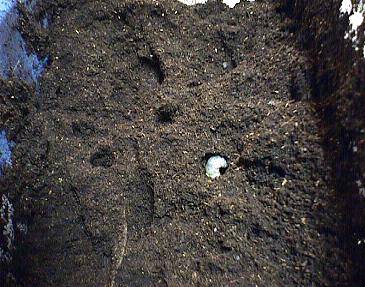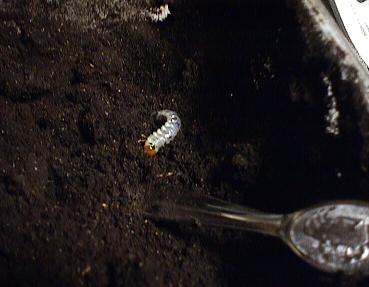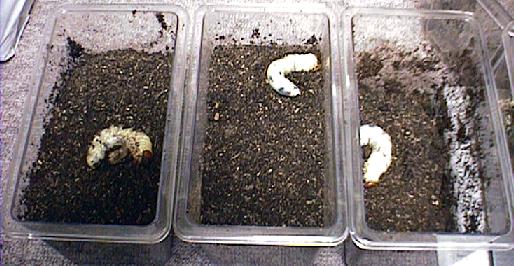5. Rearing of Miyama Larvae
Mild change of food environment.
Adequate control and adjustment of temperature and moisture.
(1) Cool in summer
(2) Warm in winter
(3) Very humid throughout the year
Just like other stag beetles, Miyama also lives in symbiosis with bacteria in its body. When you change the food/environment, avoid acute environmental change by moving the larva with old mat to a new case and gradually adding new mat as food. For moisture control, you can place a sheet of cellophane between the lid and the container. If you rear them indoors, Miyama don't hibernate, but as I want them to emerge more quickly, I rear them in a greenhouse. This will shorten the larva period by one year. If you rear them outside a greenhouse, it will take 2 years till their emergence, but I think they may grow into larger imagoes.
 Rearing of larvae 1.
Rearing of larvae 1.
When all the imagoes are dead, place a sheet of kitchen wrap between the lid and the container. Pierce some 60 small holes in the wrap using a needle for ventilation. When the largest larva grows to about 1cm, it's time to separate them into individual cases. You can wait till they grow as large as 2cm. If you wait that long, the latest eggs must have hatched, too. You can also retrieve them as egg or 1st instar, but many eggs may not hatch, and young hatchlings may die very easily. I used to separate them in the 1cm stage for sure, but now I feel that I can be lazy and retrieve them much later, as weak ones would die soon or later anyway. Once you rear them, you will surely discover that the larvae make rather loud warning noise ("gikogiko...") by rubbing their legs together. It seems that they try to avoid unnecessary encouters with each other by this warning noise. I personally believe that those stags that make this kind of loud noise are less cannibalistic.


 Rearing of larvae 2.
Rearing of larvae 2.
This is how I retrieve the larvae. I do my best not to damage the larvae. I use a partitioned case with dividers like this for young larvae. It's very compact and convenient. It is sold for about 1000 yen at a DIY shop or you can find similar lure cases in a fishing store. It is made roughly enough that you don't have to pierce air holes. Even within the same case, some sections become dry somehow, so you had better check occasionally and make sure you spray water on those parts. Do not touch the larvae directly with your hands. Use a spoon or some other tool. It will save the larva from the germs on your hand and it prevents the larva from biting your fingers.
 Rearing of larvae 3.
Rearing of larvae 3.
When the larva becomes 2nd or 3rd instar, it should be transferred to a miniplastic container. The one in the picture can be divided into two sections by the divider in the middle. I bought them by mail order. I think they were about 200 yen apiece when I bought 4 dozen. A female can be reared in this section till emergence. But a male may have trouble at emergence, so I rear male larvae in an undivided miniplastic container.
 Rearing of larvae 4.
Rearing of larvae 4.
As you can see in this picture, wandering on the mat is one of the characteristics of Miyama larvae. I think there are two reasons for this behavior. One is excessive dryness in the environment and the other is suffocation. Remove the kitchen wrap that was meant to prevent drying, and spray water with the atomizer, making sure that the water does not hit the larva directly. Most of the time, the larva digs into the mat again on the following day, if you just leave it alone after spraying. If it comes out again, add more mat and watch carefully, paying attention to the moisture level. In that case, don't rely on the kitchen wrap, and control the moisture for a while by spraying. When the larva digs in again, place the wrap again between the lid and the container.
Rearing of larvae 5.
The following picture shows how I change the food for 3rd instar larvae.
In my case, maybe I should say "add" rather than change. As the larva grows, I keep adding mat, so it continues to get deeper. I always add the same amount as the old mat, so the new environment is doubled in mass. Can you see that the larva in the right corner is somewhat more yellowish than the others? This is a larva ready to pupate soon. People who don't rear stag beetles may think it is quite weird to rear many "worms", but once you try, it is even more enjoyable than rearing imagoes. I feel I am profiting by looking at those larvae growing day by day.

Index
 Rearing of larvae 1.
Rearing of larvae 1.

 Rearing of larvae 2.
Rearing of larvae 2. Rearing of larvae 3.
Rearing of larvae 3. Rearing of larvae 4.
Rearing of larvae 4.